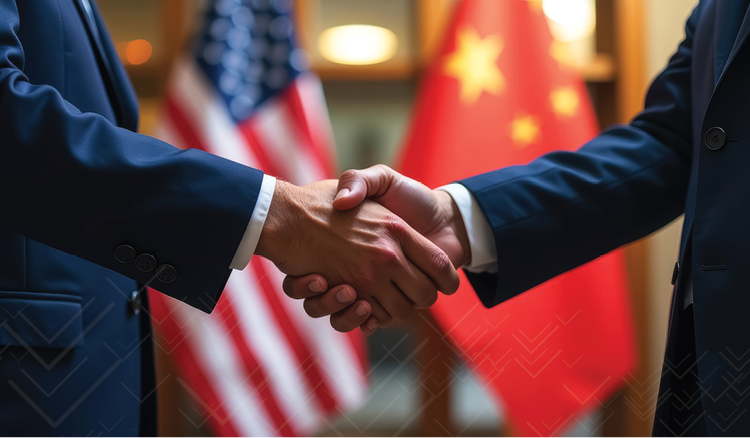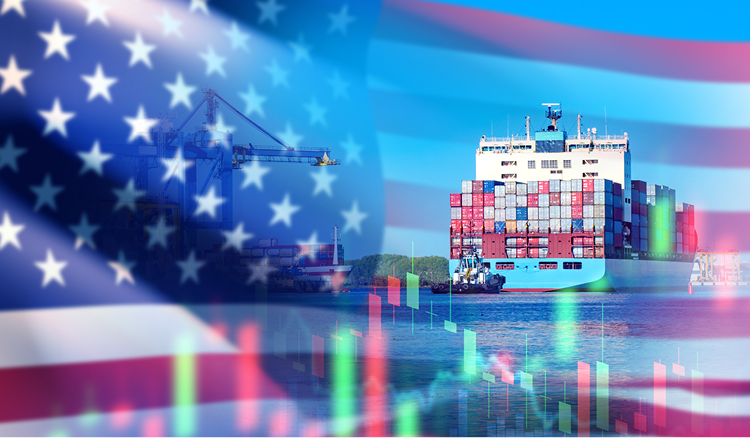Trump 2.0 Week 17 In Review: Discussing The China Trade Deal, The Reduced De Minimis Duties, and More
Between the dramatic reductions of the tariffs on China and the reduced de minimis duties, this past week was full of surprises.
In this week’s recap, we discuss:
- The outcome of last weekend’s U.S.-China negotiations
- The reduced de minimis duties
- Trump puts pressure on 150+ countries to make a deal
- Other trade negotiation-related developments
U.S. and China Agree To Roll Back Tariffs
Last weekend, U.S. Treasury Secretary Scott Bessent and Trade Representative Jamieson Greer met with Chinese officials in Geneva to begin trade negotiations. While nobody really knew what would come of these following mixed signals from both sides prior, President Trump shocked the world Sunday night when he announced via TruthSocial that a deal had been reached with China.
Specifically, the negotiations resulted in a significant reduction of tariffs, with U.S. tariffs dropping reciprocal tariffs on China from 125% to 10% and Chinese tariffs on U.S. goods falling from 125% to 10%. The 20% fentanyl-related tariff imposed in February remains in place however, meaning that goods from China are subject to a 30% total tariff.
The talks were described as constructive, with both sides expressing a desire to avoid decoupling and to work towards more balanced trade relations. They also agreed to establish ongoing consultation mechanisms to address future trade issues.
While the tariff reductions are seen as a positive step and come as good news for many consumers and businesses, it’s important to understand that they are temporary and could be reversed if negotiations break down. The U.S. is also pushing for China to purchase more American goods, though previous commitments have not been fulfilled. But, while some uncertainty still remains about long-term trade relations between the two nations, the White House has stated that the tariff on China won’t go all the way back up to 125% after 90 days if a deal isn’t reached.
As far as the impacts of this tariff reduction, we’ll see companies move to stockpile Chinese imports in order to capitalize on the reduced import costs and mitigate the impact of future tariff hikes. This of course will create a massive surge in demand for warehousing space and 3PL services.
De Minimis Duties Reduced For Now, But a Permanent Ban May Be Coming
In another move of de-escalation with China, the Trump administration temporarily eased tariffs on small-value shipments from China and Hong Kong, reducing duties and postal fees for 90 days to help retailers adjust to rising costs.
Now, duties on Chinese packages valued at under $800 are at 54%, down from 120%. While the $100 fee option still remains in place, the planned increase to $200 has been cancelled.
As far as the immediate impacts, we’ll likely see Temu and Shein move to import products in bulk to restock their warehouses ahead of the next possible tariff increase. Shein also announced on Thursday that they would be reducing prices, while Temu announced they would start selling nondomestic items to U.S. consumers again, after halting these last month.
Despite this drastic reduction, the House Ways and Means Committee approved a massive tax bill on Tuesday, which includes a provision that would permanently end de minimis for commercial shipments from all countries by July 1, 2027.
In the meantime, other efforts intended to curb the use of the exemption are already underway. For one, CPB is developing a new rule that would require certain shippers to electronically submit additional data elements on low-value consignments prior to arrival and would also remove de minimis eligibility for imports subject to certain tariffs. The White House has also stated that once systems are in place to collect duties from the 4 million + parcels per day, it will use emergency powers to remove the exemption.
When this happens, Temu and Shein will be forced to establish new U.S. production sites and warehouses in order to maintain their U.S. market share.
For context, after the unprecedented tariff increases last month, when Shein raised prices and Temu stopped shipping goods directly from China, their former shoppers spent 21% more at Nordstrom Rack than the year before in the last 3 weeks of the month, according to Consumer Edge.
Additionally, in April, Temu experienced a sharp decline in spending growth among U.S. customers, dropping from nearly 50% year-over-year at the beginning of the month to nearly 0% by the end, based on credit and debit card data analyzed by Consumer Edge. Similarly, Shein's U.S. spending growth also slowed significantly, decreasing from 30% at the start of April to 20% by month's end.
Trump Puts Pressure on Trade Partners to Make a Deal or Face Higher Tariffs
On Friday at the conclusion of his Middle East trip, President Trump acknowledged that negotiations are progressing too slowly to make a deal with every country, stating “We have, at the same time, 150 countries that want to make a deal, but you’re not able to see that many countries. So at a certain point, over the next two to three weeks, I think Scott and Howard will be sending letters out, essentially telling people – we’ll be very fair – but we’ll be telling people what they’ll be paying to do business in the United States.”
In the meantime, Trump’s trade team is actively negotiating with about a dozen countries and is supposedly getting close to finalizing several agreements with India, Japan, and South Korea. It remains unclear however what new tariffs will be imposed on countries that fail to reach deals in the coming weeks, and whether these tariffs will replace or serve as interim measures for existing paused tariffs. Currently, the U.S. maintains an average tariff of around 13%, up from 2.3% before Trump’s administration, and Trump has indicated that tariffs could rise even higher, potentially reaching 50%.
Other Recent Developments
EU Revises Proposals in Effort To Expedite U.S. Trade Talks
In an effort to speed up negotiations, the EU announced Thursday that they are revising proposals for a potential U.S. trade deal. Specifically, the new plan aims to reduce trade and non-tariff barriers and increase European investments and purchases in the US, including the energy and semiconductors sectors. EU officials say the Trump administration’s willingness to strike a deal with the UK and significantly reduce its tariffs on China gives them optimism that a favorable agreement could be reached, though they also emphasized they’re prepared to move forward with retaliatory tariffs if negotiations fail.
Despite this, many European officials are confused about what exactly Trump is looking for. One major disagreement is regarding Trump’s assertion that the EU’s value-added tax is a non-tariff barrier, even though EU officials are adamant that it isn’t and that their control over tax and regulations isn’t negotiable. Additionally, the Swedish minister for development cooperation and foreign trade, Benjamin Dousa, stated that “if the UK-U.S. deal is what Europe gets, then the U.S. can expect countermeasures from our side,” he said. “We will not be happy with that kind of deal.”
Cambodia Holds Trade Talks With U.S.
On Thursday, Cambodia held its first round of negotiations with U.S. officials in Washington, according to its government. While neither side have alluded to what was discussed in these negotiations, the cards are certainly in the Trump administration’s hands. For context, the U.S. is Cambodia’s largest export market, and in 2024, 37.9% of total shipments from Cambodia were sent to America, valued at roughly $10 billion. As of now, a second round of negotiations has been planned for early June, although this could happen sooner given Trump’s recent comments.
Japan To Hold Out for Better Trade Deal
While recent reports have indicated that a deal with Japan could be announced in the near future, recent comments from Japanese officials could throw a wrench in things. Recently, Japan indicated that it is prepared to hold out for a better deal with the U.S. over tariffs, and will push for the full removal of his 25% tariff on imports of Japanese cars. The main reason for this is that the Japanese government is facing domestic pressure to shield their automotive and agricultural sectors ahead of an upcoming election. With that being said, Japan and the U.S. are currently planning another round of negotiations, with a leading Japanese negotiator planning to visit America as soon as next week.
India Offers Zero Tariffs To Trump… Or Did They?
On Thursday at a meeting with business leaders in Qatar, Trump claimed that India has offered to completely eliminate tariffs on America, stating “India is the highest — one of the highest tariff nations in the world. It’s very hard to sell into India, and they’ve offered us a deal where, basically, they’re willing to literally charge us no tariff." While Indian officials later said that a deal wasn’t complete yet and that “nothing is decided till everything is”, they certainly didn’t rebuke Trump’s claim. With India’s tariffs amounting to 70% on cars, 37.7% on agricultural products, and 20% on some networking equipment, the removal of these tariffs would provide a major boost to U.S. companies and would allow them to compete in a market that they previously have never been able to. With Indian officials set to visit the U.S. later this month to move talks forward, expect more clarity on this matter to come in the near future.
Inflation Hits 4-Year Low In April
Coming as a surprise to many, April’s CPI report showed that consumer prices increased 2.3% over the prior year in April, a slight slowdown from 2.4% in March and below experts' predictions for 2.4%. On a month-to-month basis, prices increased 0.2%, lower than the 0.3% estimated by economics. This marks the lowest annual increase since February 2021.
Operational Agility Is The Key To Winning In This Unpredictable Environment
Each of these changes presents both opportunities and challenges, and those that will come out ahead are those that are agile and can quickly adapt. By leveraging Veryable, businesses gain access to a team of experienced operations strategists and a suite of tools that not only improves key operational metrics, but provides a significant operational competitive advantage. With a labor pool at the ready, businesses can respond immediately to changing market conditions, minimize the risks of over or understaffing, and seize new opportunities with infinite flexible capacity.
To learn more about how Veryable can help you maximize agility and stay ahead of the curve, check out these articles:
The Pressure That Creates Progress: Why Those Who Move First Win The Most: The companies that adapt first don’t just survive; they capture market share, drive innovation, and cement themselves as leaders. Those that hesitate become irrelevant, outpaced, or acquired by the competition.
Agility Drives Profitability: How Veryable Enable Rapid Business Pivots: Agility isn’t just a luxury—it’s a necessity. Companies that build flexibility into their labor model are best positioned to adapt, grow, and dominate their industries.
The Reshoring Reckoning: Why American Manufacturing Can't Afford to Wait This One Out: As tariffs and reshoring reshape global trade, American Manufacturing faces a pivotal moment. This article explores why operations clinging to rigid workforce models will falter while those embracing operational agility with Veryable will thrive.
Profiting From Preparation: Getting Paid to Build Your Operational Ark With Veryable: With Veryable, preparation isn’t just about readiness; it’s about opportunity. From day one, it creates profit and strengthens operations while preparing you for the unexpected.
U.S. Manufacturing Today Podcast
We’ve recently launched our U.S. Manufacturing Today Podcast. Hosted by our Head of Reindustrialization, Matt Horine, this podcast intends to help you cut through the noise you’re seeing across constructed narratives and provide clarity around these once in a generation policy shifts and their impact on the U.S. manufacturing sector.
Next week’s episode, which will be released on Tuesday May 20th, will feature Jim Vinoski, seasoned manufacturing executive and host of the Manufacturing Talks Podcast.
You can find this podcast on our website, Spotify, Apple, YouTube, and PocketCasts.
Additional Resources
For more information on the changes taking place under Trump 2.0, make sure to check out our “Navigating Trump 2.0” page. Here you’ll find more info on what’s happened so far and what’s potentially to come, as well as more articles laying out how manufacturers and distributors can thrive in this uncertain environment.
Previous Posts
Trump 2.0 Week 30 In Review: Discussing The China Deadline Extension, The Potential For Even Higher Tariffs on India, and More
The Future of Manufacturing and Logistics
Create a free business profile today to explore our platform.






